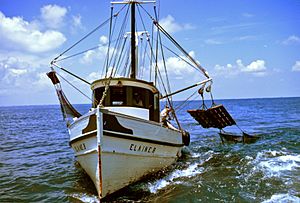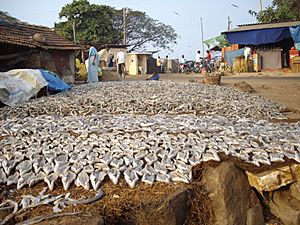Fishing industry facts for kids
The fishing industry includes everything about fish! It's all the activities involved in growing, catching, processing, or moving fish. This can be for fun, like a hobby, or as a big business.
The FAO says it covers recreational fishing, traditional fishing, and commercial fishing. It also includes harvesting, processing, and selling fish. Commercial fishing aims to provide fish and other seafood for people to eat. It also supplies ingredients for other industries. More than 500 million people, especially in developing countries, rely on fishing and aquaculture for their living.
Contents
Main Fishing Industry Sectors
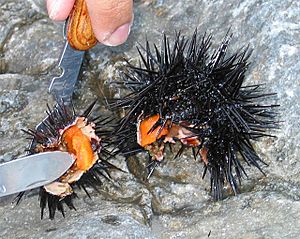

The fishing industry has three main parts:
- The commercial sector: This part includes businesses and people who catch fish from the wild or raise them on farms. They turn these fish into products to sell. It's often called the "seafood industry." They sell food items, but also things like pearls.
- The traditional sector: This involves people who use fishing resources based on their old traditions. This is often done by aboriginal people.
- The recreational sector: This part is for fun, sport, or getting food for yourself. It includes people and businesses linked to fishing for hobbies, not for selling.
Commercial Fishing Activities
Commercial fishing is a huge business worldwide. The top countries that catch the most fish include China, Peru, Japan, and the United States. China alone catches about one-third of the world's fish!
Fish Farming (Aquaculture)
Aquaculture is like farming, but for water animals and plants. Instead of catching fish in the wild, aquaculture means raising them in controlled places. This could be in tanks or special ponds. When it's done in the ocean, it's called Mariculture.
Some types of aquaculture include:
- Growing kelp or seaweed (algaculture).
- Raising fish (fish farming).
- Farming shrimp or shellfish.
- Growing cultured pearls.
Fish farming means raising fish in tanks or enclosed pools, usually for food. Common fish raised this way are carp, salmon, tilapia, and cod. Wild fish populations are getting smaller because of too much commercial fishing. Fish farming helps meet the growing demand for fish and fish protein.
Fish Processing
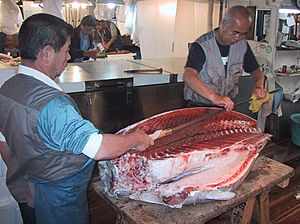
Fish processing is about preparing fish after they are caught or harvested. Large processing companies often have their own fishing fleets. They also buy fish from independent fishermen. The processed fish are usually sold in large amounts to grocery chains or other businesses.
Fish processing has two main steps:
- Fish handling: This is the first step, dealing with the raw fish.
- Fish products manufacturing: This involves making different products from the fish.
Some processing happens right on the fishing vessels. Other steps take place at special fish processing plants on land. This can include filleting and freezing fresh fish. It also includes making chilled, frozen, or canned products for stores and restaurants.
Fish Products and Uses

Fish provide about 16% of the world's protein. Many types of fish are eaten as food. Other sea creatures eaten include shellfish, crabs and lobsters, sea cucumbers, jellyfish, and fish roe (eggs).
But fish and marine life are used for more than just food!
- Pearls and mother-of-pearl come from shellfish.
- Sharkskin and rayskin are used for leather.
- Sea horses, starfish, sea urchins, and sea cucumbers are used in traditional Chinese medicine.
- Tyrian purple is a dye made from marine snails.
- Sepia is a brown pigment from cuttlefish ink.
- Fish glue has been used for many products.
- Isinglass helps make wine and beer clear.
- Fish emulsion is a fertilizer made from fish remains.
In the industry, the term seafood products is often used instead of fish products.
Traditional Fishing Sector
The traditional fishing industry is also called artisan fishing. It describes small-scale fishing, often for personal use or local sales. These fishers use old methods like rods, arrows, harpoons, or simple nets. This sector is different from large modern commercial fishing. It often focuses on fishing at a level that helps people feed themselves and their families.
Recreational Fishing Sector
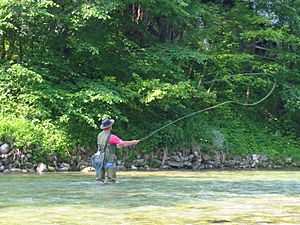
The recreational fishing industry is all about fishing for fun. It includes companies that make and sell fishing tackle and clothes. It also involves paying for fishing licenses. This sector includes fishing books and magazines, and companies that build recreational fishing boats. You can also find places to stay, boats to rent, and guided fishing trips.
See also
 In Spanish: Industria pesquera para niños
In Spanish: Industria pesquera para niños



